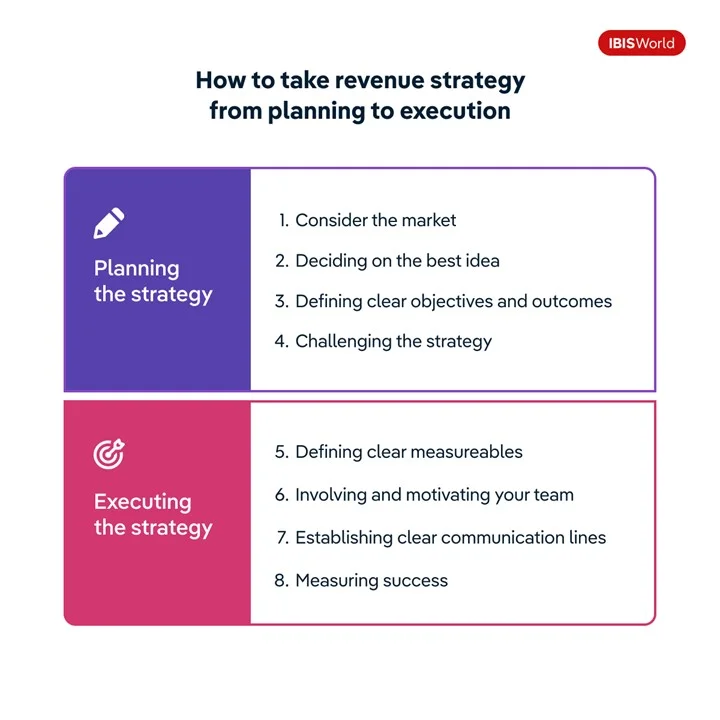Key takeaways
Bringing a strategy to life requires grasping the importance of both planning and execution.
Not every good idea guarantees success, and strong execution is more important than meticulous planning.
Effective strategies require clear objectives aligned with business goals and a deep understanding of market dynamics.
Revenue leaders are often tasked with complex challenges, ranging from driving pipeline growth to expanding demand in new markets. During my tenure at IBISWorld, I’ve spearheaded numerous initiatives as both Vice President of Sales and Head of European Operations, to achieve a range of outcomes for the business. One of the biggest lessons that I’ve learned along the way is that you can have the greatest ideas for sales growth, but without a strategic approach to taking an initiative through its full life cycle, you may find yourself facing lost deals and missed targets.
However, the path from an idea to a fully executed strategy is not as straightforward as setting a goal or implementing a new tool. A brilliant idea does not automatically guarantee success. The most impactful strategies succeed because they involve careful planning, rigorous execution and constant monitoring and adjustment.

Phase one: planning the strategy
The initial planning stages are essential for validating that a strategy is practical, realistic and deliverable, given the resources available. A simple and realistic strategy that can be executed effectively beats a complicated, multi-layered one that could get lost in its delivery. Use these four steps to keep your planning stages focused and productive:
1. Consider the market
Understanding market dynamics is a crucial step in shaping your sales strategy. Consider the economy, competitive landscape, clients and timing as you fine tune your approach.
Data is the compass that guides sales teams toward identifying and solving the most relevant problems, but it’s often one we let take a backseat because anecdotal evidence makes for a better story. Every decision, hypothesis and change proposed must be at least partially grounded in facts, not just gut feeling or intuition. By digging into metrics and patterns, sales leaders can gain valuable insights into their market and the effectiveness of current practices.
It’s also pivotal to evaluate how current economic conditions and market trends affect your customers’ needs and preferences. The timing of your strategy is vital — even the best strategies can fail if you don’t align with the right buying cycle, or if you’re too late to the game.
2. Deciding on the best idea
After digging into the data, there should be multiple options on the table, and your next step is to decide which one (or which combination) will be the best strategy for your business. Choosing the right idea is not just about picking the most innovative one. It involves considering several factors, such as:
- Team capacities
- Individual capabilities
- Personnel allocations
- Time requirements
- Upfront and on-costs
- Business structure
These plans will almost always cross over to other parts of the business, so the decision cannot be made in isolation. It’s important that you’ve involved the right stakeholders and have thoughtfully considered how the data, objectives or resources might differ across all departments. While stakeholders may have conflicting priorities, the best idea is usually the one that offers the clearest route to success for the business as a whole. It should be executable and practical for all parties involved.
3. Defining clear objectives and outcomes
Clarity on your objectives and goals is crucial to keeping alignment across the business, especially when stakeholders may have different opinions on the approach. The outcomes you outline should directly contribute to and align with the organisation’s larger business goals. It’s important to make sure you focus on the what at this stage, not the how. Clear objectives should represent the final, envisioned state resulting from successfully executed strategy; they provide a sense of direction, purpose and success for everyone involved to get behind. You’ll have plenty of time to define the specific, measurable steps that are needed to achieve these objectives once everyone is aware of the bigger goal that you’re working toward.
4. Challenging the strategy
Getting additional perspectives from leadership and relevant stakeholders is one way to help challenge your strategy; others can help identify potential gaps and brainstorm adjustments that will improve the outcome. However, it is also important that you take time to critically evaluate your own work and challenge the strategy you’ve helped to form:
- Did you eliminate other options for the right reasons?
- What’s the business’s appetite for change, and do you have the right resources for effective change management?
- Does this strategy align with the long-term vision of the company?
- Have potential risks and obstacles been identified and planned for?
- Is there a contingency plan in case the strategy does not produce the expected outcomes?
Encourage open discussion and welcome feedback from all stakeholders involved. This can help identify any potential flaws in the strategy and allow for necessary adjustments to be made before implementation.
Lessons learned: balancing enthusiasm and avoiding assumptions
Balancing Enthusiasm with Focus in Leadership

Like many sales leaders, I initially entered my role at IBISWorld brimming with enthusiasm and a desire to make an immediate impact. In my early days as a Sales Manager, I was desperate to contribute and chock-full of improvement ideas based on my own sales successes. However, when I tried to introduce a handful of improvements simultaneously, I inadvertently diluted the effectiveness of each individual strategy. Introducing too many new initiatives at once can overwhelm even the most exceptional salespeople, leading to divided focus and unclear accountability.
This experience taught me the importance of a balanced approach, where enthusiasm for improvement is considered balanced with a focus on cohesion and team alignment. Only a strategic and collaborative approach can empower teams and achieve sustainable success.
Avoiding the pitfalls of misplaced assumptions
On this leadership journey, I learned the critical importance of challenging my own assumptions. It’s easy to fall into the trap of overconfidence, in which past successes and personal biases distort our perspective. This can lead to crafting strategies based on shaky foundations, such as assuming results without considering context, estimating figures and trends instead of relying on data or ignoring current market conditions. To avoid these pitfalls, it is vital to cultivate a culture of due diligence. Before you let yourself get stuck on an idea, rigorously test its efficacy by poking holes, questioning the data and courting diverse feedback. Professional growth comes from being capable, being open to being wrong and changing course. Ultimately, prioritising data, critical thinking and a bit of humility will pave the way for success beyond the limitations of assumptions.
Phase two: executing the strategy
When launching a strategic initiative, careful planning is undoubtedly essential, as it’s the ability to translate strategy into action that ultimately determines success. A well-executed but imperfect plan will always surpass a flawless plan that is poorly implemented. Executing a plan requires unwavering focus, not just on the initial implementation, but on consistent delivery, ongoing measurement and the active involvement of personnel throughout the entire process.
1. Defining clear measurables
Success should be clearly defined in terms of inputs and outputs. These measurables should be realistic and, where possible, align with historical quantitative measures. They provide a clear vision of what success looks like and help track progress effectively.
It’s crucial to define both short-term and long-term metrics, as well as milestones along the way. By evaluating progress over time, you can identify areas that require improvement and make necessary adjustments. Remember to establish an accurate and transparent way to track each of your relevant measurables.
2. Involving and motivating your team
A successful sales strategy isn’t just about a good plan; it’s also about having the right people to execute it. This includes not just your sales floor, but leaders in the business who can help with training, accountability and change management. Transformational changes are almost always met with some resistance; to successfully facilitate change management for bigger initiatives, you should get your team involved early. Exposing them to the vision and projected outcomes will lead to better buy-in and keep them motivated toward your desired results, rather than just accepting the responsibilities that are delegated to them. Engage your team, define clear roles, empower them and make sure everyone comprehends their role in making the strategy successful.
3. Establishing clear communication lines
Communication plays a crucial role in implementing a strategy and throughout its execution. From the top to the boots on the ground, communication should be transparent and two-way. Your team should communicate quickly and establish robust mechanisms for feedback.
This allows for effective decision-making and keeps everyone informed on the progress of the strategy. Remember, an open communication culture fosters trust and collaboration within the team, leading to a more successful execution.
Poor communication within the sales process can lead to misaligned goals, wasted resources and missed opportunities. It creates friction in the strategy execution process, which can ultimately have a significant impact on your results.
4. Measuring success
Regularly measure, review and adjust your strategy where necessary. This allows you to track your progress towards your objectives and make adjustments to ensure you’re on the right path to achieving your desired outcomes.
To stay agile in your sales strategy, remember that success is a moving target. Continuously review and optimize to effectively address challenges and propel your business forward. Once you’ve reached your goals, set new ones or pivot to impact different areas of your business outcomes.
Remember, in order to succeed, you first have to fail. Measure and analyze the aspects of your strategy that didn’t yield results to learn and grow.
Lessons learned: communication, engagement and measurable goals for flawless strategy execution
Communication and engagement for flawless implementation
Following a comprehensive review of new client close rates and existing client retention rates, segmented by industry and sub-industry, we identified a clear pattern. Certain client sub-segments demonstrated a significantly stronger need for our product, leading to faster adoption and longer-term retention. This alignment perfectly matched our core business goals, as we prioritize both customer service and client retention.
This helped us to define our ideal customer profile (ICP) for the region and decide which segments of the European market to prioritize and where to reduce our focus. However, we made a crucial misstep in neglecting to fully engage our salesforce during the strategic shift. Our salespeople had diligently built their pipelines within some of the verticals we wanted to de-emphasize in favour of those with demonstrably higher returns. Despite the lower potential yield of these existing pipelines, significant effort had already been invested in their development. Unfortunately, the rationale behind the strategic shift was not clearly communicated, leading to demotivation among some of the team when we implemented the new, verticalized approach. While the strategy ultimately yielded significant success, the initial lack of employee buy-in and engagement hindered the initiative’s initial momentum and potentially jeopardized its overall success.
Successful strategies cannot be implemented alone and change management across the floor is essential. Engaging employees, stakeholders and even customers through clear communication, shared decision-making and continual feedback are crucial. Without the support of the teams involved, the path to success can be fraught with motivation, communication and implementation challenges.
Setting measurable goals for execution success

The strategies that we have executed with the greatest success all have the same thing in common: clearly defined, measurable goals along the journey towards a well-defined ultimate objective.
On this point, our strategic accounts initiative, which redefined our approach to targeting high-value clients, was well executed. We began by defining “success” for each account, leaning on what we had learned from previous sales cycles for large deals. This involved outlining current engagement and next steps with clear 30-60-90 day action plans and setting a well-defined end goal. To track progress, we established expectations for account mapping, pipeline generation, account development and qualification criteria, incorporating minimum account value thresholds. This allowed us to measure the entire sales journey for each strategic account.
Each team member understood what they were accountable for when working on a strategic account, and our high expectations remained unwavering. We rewarded team members for achieving results through this process, and we adjusted when accounts were not managed appropriately. We set a transparent goal of achieving 50% of European revenue from these accounts, with clear, measurable milestones and room for adaptation. Regular check-ins, both at individual and leadership levels, ensured everyone understood their individual contribution to each account and contributed to the overall strategy. This transparency empowered individuals at every level and fostered a collaborative environment.
By translating broad strategic priorities into specific, quantifiable objectives for each stage of the sales journey, we ensured everyone was aligned towards achieving the desired outcome. Ultimately, we exceeded our initial revenue target by over 10%, which was a positive outcome for the business, and also a celebrated success for the people involved. The fact that our sales team celebrated this outcome, even after a rocky start for some, serves as a testament to the role that measurable goals play in any strategic initiative.
Final thoughts
While meticulous planning forms the blueprint, flawless execution determines a strategy’s true impact. Consistent effort, continuous measurement and active participation fuel the journey. Yet, successful execution hinges on effective change management. Clear communication, team engagement and measurable goals are crucial. By prioritising these elements, fostering collaboration and setting clear objectives, organizations can transform ambitious plans into impactful realities, paving the way for sustainable success.
Source from IBISWorld
Disclaimer: The information set forth above is provided by ibisworld.com independently of Alibaba.com. Alibaba.com makes no representation and warranties as to the quality and reliability of the seller and products.








